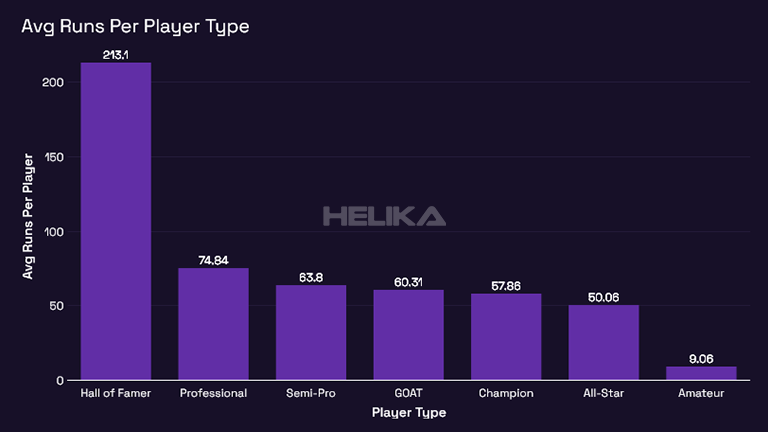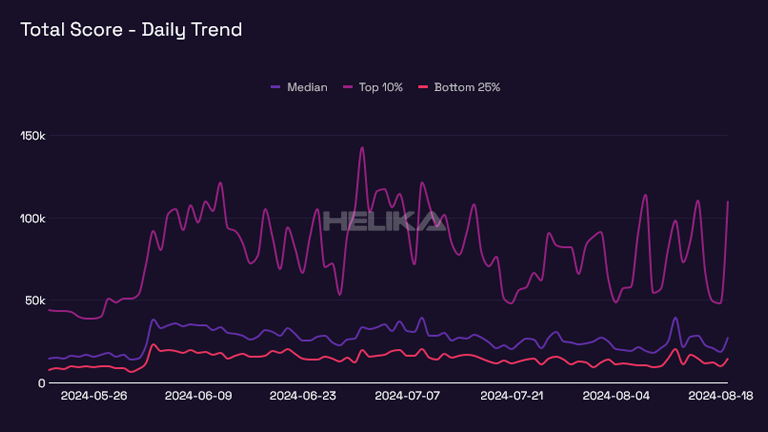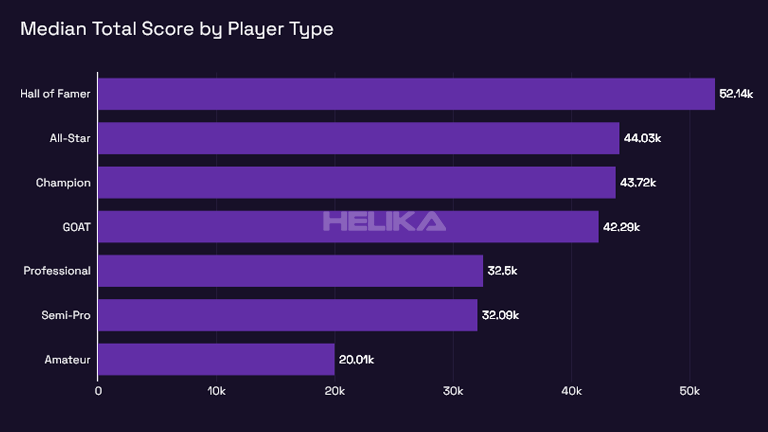Fairness is pivotal to games. Who wants to play a game that is rigged in someone’s favor? A balanced game ensures that all players have an equal chance of winning, without any unfair advantage given to certain players. However, achieving balance in games is not a simple task.
In this article, we’ll shed some light on game balancing strategies and provide tips for game designers to create a more balanced gameplay experience. Whether you’re designing a role-playing game, real-time strategy game, or a competitive multiplayer game, these tips will come in handy. Plus, as the leading game analytics company here at Helika, we’ve gathered insights from our data analysis to support these strategies.
Game Balancing Basics
All games have a certain degree of constraints and limitations which create the challenge for players. This is true even for free roam sandbox games, as players have to navigate the game world and make choices within the available options. To keep players engaged and provide an enjoyable experience, game developers must carefully balance different aspects of the game.
So what are the basics when it comes to designing a balanced game? Below are some key strategies and tips to consider.
Understanding Player Skill
One of the trickiest things about game balancing is catering to players of different skill levels. Every player has a “skill curve” that represents their individual learning and improvement over time within a particular game. This means that what may be challenging for one player may be easy for another. Past experience can be difficult to measure, so it’s important to consider a wide range of players, from beginners to experts.

Of course, for single player games adjusting the difficulty level is a simple solution. However, for multiplayer games it’s important to find a balance that provides an enjoyable experience for players of all skill levels. Many multi-player games match players based on experience and this helps to create a more level playing field. However, experience doesn’t always equate to skill. Thus, adding lose and win ratios to the match making process may further aid in balancing.
Identifying Key Mechanics
Balancing a game requires understanding the key mechanics that make up gameplay. These can include movement speed, attack power, and special abilities among others. It’s important to identify which of these mechanics are crucial to the game experience and which are less important. Focusing on those key mechanics allows for more targeted balancing efforts.
Another aspect to consider is the interactions between different mechanics. For example, a player with high movement speed can easily evade attacks from a player with low attack power. Identifying these relationships and their impact on gameplay is essential in creating a balanced experience. So, it’s not just about identifying these variables but also how they interact with each other. At this point, using advanced data analytics and player feedback can provide valuable insights.
Importance of Playtesting and Feedback
Once the key mechanics have been identified and potential imbalances have been addressed, it’s important to playtest the game extensively. This involves having a diverse group of players with varying skill levels try out the game and provide feedback. Playtesting not only helps in finding any remaining balance issues but also allows for fine-tuning of gameplay mechanics.
Additionally, listening to player feedback is crucial in balancing a game. Players often notice things that developers may overlook or not consider as important. Taking their opinions into account can greatly improve the overall balance of a game.
Constant Re-evaluation
Balancing a game is an ongoing process that should continue even after its release. As players become more experienced and find new ways to approach the game, imbalances may arise. Therefore, it’s important for developers to continuously gather data and feedback from players and make necessary adjustments to maintain a balanced gameplay experience.
Having a data analytics partner like Helika can help developers in this process by providing real-time insights and player behavior analysis. This allows for quick identification of imbalances and efficient adjustments to maintain a balanced game. One of the most common reasons why a game fails to retain players is due to poor balance, which can easily be avoided by constantly re-evaluating and fine-tuning the game.
Analysts can also provide actionable insights on how to rebalance the game and retain players. This is an asset. Ignore at your own peril. Feel free to contact us to learn more about how we can help you in maintaining a balanced game and keeping your players engaged.
Fairness In Randomness
If for example a power up was appearing closer to your enemy just 1% more than you, that’s a huge difference when dealing with randomness. This is why fairness in randomization is an important aspect of game balancing. Developers must ensure that the distribution of random elements like loot drops or power up appearances are fair and balanced for all players.
This can be achieved through proper algorithms and testing to minimize any possible biases. A data analytics partner can also provide insights on the fairness of randomness in the game, helping developers to make necessary adjustments for a more balanced experience for all players.
Simple Rules Are Key
Clear rules and simple mechanics are essential for a balanced and enjoyable game. Complicated rules or convoluted mechanics can make it difficult for players to understand the game, leading to frustration and imbalances in gameplay. According to ‘Systems Thinking’ the more complex a system is, the harder it is to balance. This applies to games as well – the more complicated the game mechanics are, the harder it will be to achieve balance.
Now, I know what you might be thinking. “But what about games like League of Legends or Dota 2? They have many complex mechanics and are still balanced.” While it is true that these games have a high level of complexity, they also have teams of developers constantly monitoring and adjusting the game balance.
For smaller games or indie developers, it may not be feasible to have a large team dedicated solely to balancing the game. Therefore, keeping the rules simple and clear from the beginning can save time and resources in the long run. The key is to keep in mind that a balance between complexity and simplicity is crucial for a successful game. To find the optimal balance, it is essential to understand the different aspects of game balancing and the strategies that can be employed.
Different Strategies For a Well-Balanced Game
Now that we have established the importance of simplicity in game rules, let’s delve into some strategies that can help achieve a balanced game.
- Playtesting: As mentioend earlier, this is one of the most crucial steps in balancing a game. Playtesting involves testing your game with real players and gathering feedback on their experience. Through this process, you can identify any imbalances or issues that need to be addressed. It also allows you to see how different players approach the game, providing insights into potential areas for improvement.
- Iterative Design: With playtesting, it is important to take an iterative approach to design. This means making small changes based on player feedback and constantly re-testing until a balance is achieved. A\B testing can also be used to compare different versions of the game and see which one performs better.
- Data Analysis: In addition to player feedback, data analysis can also play a significant role in balancing a game. By tracking metrics such as win rates, player choices, and game statistics, developers can gain valuable insights into what is working and what needs to be adjusted. This is one of the best ways to balance a game objectively.


- Balancing Tools: There are also various tools and software available specifically for game balancing. These tools use algorithms and simulations to analyze various aspects of the game and provide suggestions for improvements. This can be a helpful resource for developers looking to fine-tune their game’s balance.
- Game Mechanics: The core mechanics of a game, such as scoring systems, character abilities, and resource management, can greatly impact its balance. Carefully designing these mechanics with balance in mind can make the playtesting and balancing process smoother.
- Community Involvement: It is also important to involve the game’s community in the balancing process. This can be done through beta testing, surveys, and forums where players can share their thoughts and suggestions. Not only does this provide valuable feedback, but it also helps foster a sense of ownership and investment in the game for players.

- Continuous Monitoring: Game balancing is not a one-time event, but an ongoing process. Even after a game’s release, developers should continue to monitor and make adjustments based on player feedback and data analysis. This ensures that the game remains balanced and enjoyable for players in the long run.
Balancing Character Abilities
Although we touched on game mechanics in the previous section, balancing character abilities deserves its own focus. This aspect is crucial for games that involve multiple playable characters with unique abilities or classes with different strengths and weaknesses.
When designing these characters, it’s important to consider their balance not only within their individual class but also compared to other characters. Some ways to achieve this are:
- Rock-Paper-Scissors Design: This design approach involves creating a triangle of strength and weakness among the different character types. For example, one character may excel at close combat while another specializes in long-range attacks.
- Trade-off System: Another method is to have each character possess a specific set of strengths and weaknesses. For instance, a character may be incredibly powerful but have low defense, while another character may have high defense but lower attack power.
- Tiered System: In this approach, characters are divided into tiers based on their strength and abilities. Players can choose from a higher tier character with fewer options or a lower tier character with more versatility.
As you can see, building a mind-map with a visual representation of the different characters and their strengths can be helpful in achieving balance. This enables you to see the interactions between characters and make adjustments accordingly.
Most Important Aspects of Balanced Game Design
Achieving balance in a game requires a holistic approach, taking into consideration various factors such as gameplay mechanics, player choices, and community involvement. However, there are certain aspects that are crucial for creating a balanced game design:
- Fairness: One of the key elements of balance is fairness. Players should feel that they have an equal chance of success and that their choices and actions have a meaningful impact on the outcome of the game.
- Challenge: A balanced game should provide players with a suitable level of challenge. It should not be too easy or too difficult to keep players engaged and motivated.
- Variety: Balanced games offer players different options and strategies to achieve their goals. This ensures that players can approach the game in their own unique way and adds to the replay value of the game.
- Progression: A well-balanced game should have a sense of progression, with increasing difficulty or new challenges as players advance. This helps keep players engaged and provides a sense of accomplishment.
- Consistency: Consistency is key in creating a balanced game design. Rules, mechanics, and player choices should all be consistent throughout the game to avoid confusion and maintain balance.
Game Theory Applications
We’ve covered the important aspects of balanced game design, but how do you actually achieve balance in a game? This is where game theory comes into play. Game theory is the study of strategic decision making, which can be applied to various fields including economics and psychology. In the context of game design, it helps analyze the interactions between players and their decisions.
Types of Games
Game theory divides games into two categories: cooperative and non-cooperative. Cooperative games involve players working together towards a common goal, while non-cooperative games involve players competing against each other. Both types of games can benefit from balanced design.
Strategies for Balanced Game Design
Game theory offers several strategies that game designers can use to achieve balance in their games:
- Dominant Strategy: A dominant strategy is one that yields the best outcome for a player regardless of what other players do. In a balanced game, all players should have access to dominant strategies.
- Nash Equilibrium: This is a state where no player can improve their outcome by changing their strategy, assuming all other players stay the same. In a balanced game, there should be multiple Nash equilibria to prevent any one player from having too much power. To explain simply, a Nash equilibrium is like a stalemate in chess where neither player can make a move without putting themselves at a disadvantage.
- Minimax Principle: This principle suggests that players should minimize their maximum possible loss. In a balanced game, no player should have an advantage by choosing to play safe or risky.
- Tit-for-tat Strategy: This strategy involves players responding to their opponent’s actions with similar actions. Many turn-based strategy games use this approach to maintain balance between players.
- Hidden Information: The inclusion of hidden information in a game can add an element of surprise and prevent players from always using the same strategies. For example, a spy tool that let’s one player see their opponent’s hand in a card game can add an element of unpredictability and balance. However, there should be a cost that justifies the advantage of having this type of ability. Deciding on the right balance of hidden information can greatly impact the overall balance of a game.
When it comes to game theory and balancing, there are many different approaches and strategies that can be used to create a fair and engaging game. Ultimately, the goal is to create an environment where players have equal opportunities and no one player has too much power or advantage over others. By understanding these concepts and applying them in game development, developers can create unique and well-balanced games that keep players engaged for years to come.
Final Thoughts
Game designers that use data analysis are at a clear advantage when it comes to creating balanced games. By understanding player behavior and making adjustments based on this data, developers can ensure that their game remains fair and enjoyable for all players.
Additionally, considering various strategies and principles from game theory can also help in achieving a balanced gameplay experience. Overall, balancing a game is an ongoing process that requires constant evaluation and fine-tuning, but by partnering with an gaming analytics company such as Helika, game developers can ensure that their game is always balanced, optimized and well-received by players. Unlock the full potential of your game with our web3 analytics platform, offering actionable insights into game telemetry, player retention, and in-game product lifecycle optimization.
Contact us today, we’re happy to learn more about your unique game development needs and help you create the next big hit in the gaming world!


